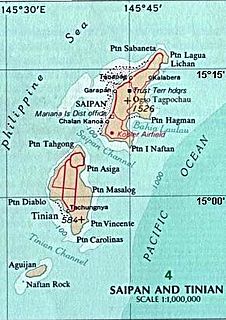
Tinian is one of the three principal islands of the Commonwealth of the Northern Mariana Islands. Together with uninhabited neighbouring Aguigan, it forms Tinian Municipality, one of the four constituent municipalities of the Northern Marianas. Tinian's largest village is San Jose.

The Mariana and Palau Islands campaign, also known as Operation Forager, was an offensive launched by United States forces against Imperial Japanese forces in the Mariana Islands and Palau in the Pacific Ocean between June and November 1944 during the Pacific War. The United States offensive, under the overall command of Chester Nimitz, followed the Gilbert and Marshall Islands campaign and was intended to neutralize Japanese bases in the central Pacific, support the Allied drive to retake the Philippines, and provide bases for a strategic bombing campaign against Japan.
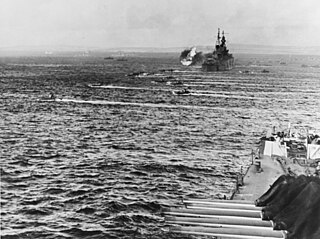
The Battle of Saipan was a battle of the Pacific campaign of World War II, fought on the island of Saipan in the Mariana Islands from 15 June to 9 July 1944 as part of Operation Forager. It has been referred to as the "Pacific D-Day" with the invasion fleet departing Pearl Harbor on 5 June 1944, the day before Operation Overlord in Europe was launched, and launching nine days after. The U.S. 2nd Marine Division, 4th Marine Division, and the Army's 27th Infantry Division, commanded by Lieutenant General Holland Smith, defeated the 43rd Infantry Division of the Imperial Japanese Army, commanded by Lieutenant General Yoshitsugu Saito. The loss of Saipan, with the deaths of at least 29,000 troops and heavy civilian casualties, precipitated the resignation of Prime Minister of Japan Hideki Tōjō and left the Japanese archipelago within the range of United States Army Air Forces B-29 bombers.

The Battle of Tinian was a battle of the Pacific campaign of World War II, fought on the island of Tinian in the Mariana Islands from 24 July until 1 August 1944. The 8,000-man Japanese garrison was eliminated, and the island joined Saipan and Guam as a base for the Twentieth Air Force.

The Battle of Guam was the American recapture of the Japanese-held island of Guam, a U.S. territory in the Mariana Islands captured by the Japanese from the U.S. in the 1941 First Battle of Guam during the Pacific campaign of World War II.

Saipan International Airport, also known as Francisco C. Ada/Saipan International Airport, is a public airport located on Saipan Island in the United States Commonwealth of the Northern Mariana Islands. The airport is owned by Commonwealth Ports Authority. Its airfield was previously known as Aslito and Isely Field.
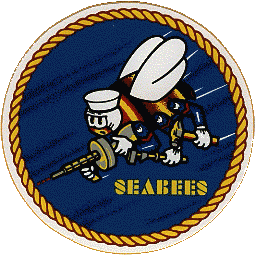
When World War II broke out the United States Naval Construction Battalions (Seabees) did not exist. The logistics of a two theater war were daunting to conceive. Rear Admiral Moreell completely understood the issues. What needed to be done was build staging bases to take the war to the enemy, across both oceans, and create the construction force to do the work. Naval Construction Battalions were first conceived at Bureau of Yards and Docks (BuDocks) in the 1930s. The onset of hostilities clarified to Radm. Moreell the need for developing advance bases to project American power. The solution: tap the vast pool of skilled labor in the U.S. Put it in uniform to build anything, anywhere under any conditions and get the Marine Corps to train it. The first volunteers came skilled. To obtain these tradesmen, military age was waived to age 50. It was later found that several past 60 had managed to get in. Men were given advanced rank/pay based upon experience making the Seabees the highest paid group in the U.S. military. The first 60 battalions had an average age of 37.

The 318th Fighter Group was a World War II United States Army Air Forces combat organization. It served primarily in the Pacific Ocean theater of World War II.

Landing Beaches; Aslito/Isely Field & Marpi Point, Saipan Island is a National Historic Landmark District consisting of several discontiguous areas of the island of Saipan in the Northern Mariana Islands. The sites were designated for their association with the Japanese defense of Saipan during World War II, the 1944 Battle of Saipan in which United States forces captured the island, and the subsequent campaigns which used Saipan as a base. The district includes the landing beaches where the U.S. forces landed, the remnants of Japanese airfields Aslito and Marpi Point and Isely Field, the airfield built over much of Aslito from which B-29 bombers were used to bomb the Japanese home islands. Included in the Marpi Point area are Suicide Cliff and Banzai Cliff, two locations where significant numbers of Japanese military and civilians jumped to their deaths rather than surrender to advancing U.S. forces. The loss of Saipan was a major blow to the Japanese war effort, leading to the resignation of Prime Minister Hideki Tojo, The landmark designation was made in 1985.

The XXI Bomber Command was a unit of the Twentieth Air Force in the Mariana Islands for strategic bombing during World War II.

East Field is a former World War II airfield on Saipan in the Mariana Islands, part of Naval Advance Base Saipan.
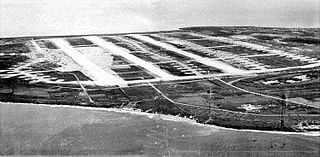
North Field is a former World War II airfield on Tinian in the Mariana Islands. Abandoned after the war, today North Field is a tourist attraction. Along with several adjacent beaches on which Allied forces landed during the Battle of Tinian, the airfield is the major component of the National Historic Landmark District Tinian Landing Beaches, Ushi Point Field, Tinian Island.
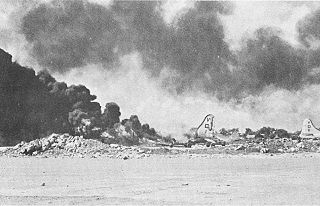
During World War II, a series of Japanese air attacks on the Mariana Islands took place between November 1944 and January 1945. These raids targeted United States Army Air Forces (USAAF) bases and sought to disrupt the bombing of Japan by B-29 Superfortress heavy bombers operating from the islands. The Japanese lost 37 aircraft during this operation, but destroyed 11 B-29s and damaged a further 43. Preparations were also made for commando raids on the bases in early and mid-1945 but these did not go ahead.
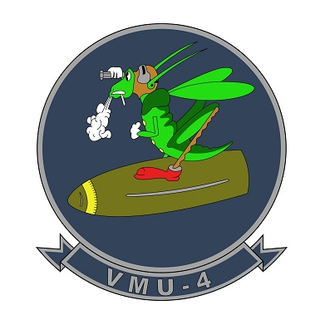
Marine Unmanned Aerial Vehicle Squadron 4 (VMU-4) is an unmanned aerial vehicle (UAV) squadron in the United States Marine Corps that operates the RQ-21 Blackjack. It is the fourth UAV squadron in the Marine Corps and the first in the reserve component. The squadron, nicknamed the "Evil Eyes", entered the force structure on 1 July 2010, when Marine Observation Squadron 4 (VMO-4) was reactivated and redesignated VMU-4.

Kobler Field is a former a World War II airfield on Saipan in the Mariana Islands, part of Naval Advance Base Saipan. It was closed in 1977 and redeveloped as a residential housing area.
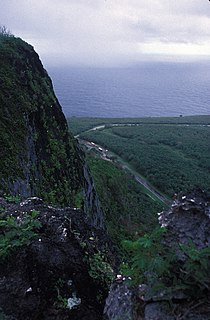
Suicide Cliff is a cliff above Marpi Point Field near the northern tip of Saipan, Northern Mariana Islands, which achieved historic significance late in World War II.
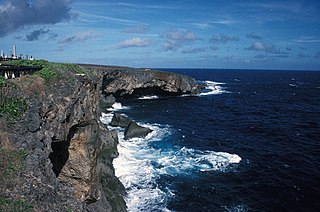
Banzai Cliff is a historic site at the northern tip of Saipan island in the Northern Mariana Islands, overlooking the Pacific Ocean. Towards the end of the Battle of Saipan in 1944, hundreds of Japanese civilians and soldiers jumped off the cliff to their deaths in the ocean and rocks below, to avoid being captured by the Americans. Not far away, a high cliff named Suicide Cliff overlooks the coastal plain, and was another site of numerous suicides. At Banzai Cliff, some who jumped did not die and were captured by American ships.
The Unai Lagua Japanese Defense Pillbox is one of the more unusual surviving World War II-era Japanese fortifications on the island of Saipan in the Northern Mariana Islands. It is located at the southern end of Unai Lagua, which stretches along the northern shore of the island. The pillbox is fashioned out of poured concrete and coral boulders, and uses natural rock formations as part of its walls. This construction was necessitated by a severe shortage of building materials on the island as the Japanese prepared the island's defenses against the advancing Allied forces in 1943–44. The use of natural materials and terrain had the added benefit of rendering the position nearly invisible to aerial or offshore observation.

US Naval Advance Bases are a number of United States Navy Naval bases built during World War 2 around the world to support the many naval war ships and boats fighting the global war. A few were built at US Allies ports, but most were built at ports captured from the rival armies of the US. In order to keep ships tactically available there was a great demand for bases that could repair and supply ships in theater, rather than return them to CONUS.Before Japan declared war on the United States the US Navy's only fully equipped advanced base was Naval Station Pearl Harbor in the Territory of Hawaii. During the war the US Navy built over 400 advance bases in the Atlantic Theater of Operations and Pacific Theater of Operations. Advance based were categorized by size. Naval bases were either Lions or Cubs. Airfields were either Oaks or Acorns. Some Advance Bases were small and only supported a few PT Boats, others were very large and could support a fleet of ships. Some of the Advance Bases also had airbases. Most bases could do refueling and overhaul; loading of troopship and cargo ships; and preparing amphibious assault ships. Some of the remote ports also became major repair depots. Advanced auxiliary floating drydocks were able to repair battle damage and do regular maintenance in the field. These ships otherwise would have returned to continental bases or Pearl Harbor. The bases also were a place for the troops to rest and regroup. Most Advance Bases were built by the US Navy's Seabees in Naval Construction Battalions (CBs). At the start of the war some civilian contractor were employed in construction. The Seabees in World War II built most of the airfields used by the United States Army Air Forces and United States Marine Corps, as they had the ships and cranes needed to transport the vast amount of equipment needed at the advance bases. The US Army and United States Coast Guard also operated out of many of these facilities. Seabees could build new or repair damaged runways, and with advancements in heavy bomber technology lengthen runways as needed. A few Naval Advance Bases were built for the Korean War and Vietnam War.

Naval Base Saipan or Naval Advance Base Saipan or Naval Air Base Saipan was a United States Navy Naval base built during World War II to support Pacific Ocean theater of war and the many warships and troops fighting the war. The base was on the island of Saipan in the Northern Mariana Islands. The base was part of the Pacific island hopping campaign. The base construction started after the Battle of Saipan ended on July, 9 1944. US Naval Advance Base Saipan was constructed by the Seabees Naval Mobile Construction Battalions. The base was under the Commander Naval Forces Marianas. Saipan is 12 miles (19 km) long and 5 miles (8.0 km) wide. About 70% of the island was sugarcane cultivation at the start of the base construction. At the start of the Battle of Saipan, the island's population had about 30,000 Japanese troops and about 20,000 Japanese civilians. The city of Garapan was the administrative center for the Saipan governmental district.



















